On-Line Remaining Useful Life Prediction of Lithium-Ion Batteries Based on the Optimized Gray Model GM(1,1)
Abstract
:1. Introduction
2. Related Algorithms
2.1. Gray Model GM(1,1)
- Step 1:
- The non-negative historical sequence X is expressed as
- Step 2:
- When this sequence is subjected to the accumulating generation operation (AGO), the following sequence is acquired. The AGO is expressed as:
- Step 3:
- The whitening gray dynamic model can be acquired by a first order differential equation with coefficient b, where b represents the influence of the external impact on the development of an event.where is a sequence of parameters that can be found as follows,where
- Step 4:
- To obtain the forecasting values of , the inverse accumulated generating operation (IAGO) is used to establish the following gray model:where .
2.2. Optimized Gray Model GM(1,1)
- Step 5:
- Using the GM(1,1) model from Equations (7) and (8) to forecast the values of the original data, the error is then written as follows:
- Step 6:
- Establish the GM(1,1) model for the above mentioned error by the same procedures as described in Equations (1)–(8), and the get the following gray model:
- Step 7:
- Combining Equations (8) and (11), obtain Equation (12).
2.3. Making Predictions
- Step 1:
- We assume that the raw data are , then the data are predicted by an optimized GM(1,1) model. This is can be represented as:
- Step 2:
- When new data are obtained, the previous data should be removed, and a new GM(1,1) model established by the series . Later, by using the new model, the series is predicted.
- Step 3:
- Steps 1 and 2 should be implemented iteratively until the last data point has been utilized.
2.4. Box–Cox Transformation
Parameter Estimation for Box–Cox transformation
3. HI Extraction and Optimization
3.1. HI Extraction
- Step 1:
- Extract the monitoring voltage and cycle index in each discharging cycle.
- Step 2:
- Define the discharging voltage interval ( and ), and extract the health indicating time series. Thus, the time interval corresponding to the discharging voltage between and can be obtained by Equation (30).
- Step 3:
- Combine the in every discharging cycle to form the HI series .
3.2. HI Optimization
3.2.1. Qualitative Analysis
3.2.2. Correlation Analysis and Evaluation
3.3. HI Performance Evaluation
3.3.1. Evaluation Criterion
3.3.2. Evaluation Result
4. Battery RUL Prediction
5. Conclusions
Author Contributions
Conflicts of Interest
References
- Lithium-ion Battery. Available online: https://en.wikipedia.org/wiki/Lithium-ion_battery?wprov=sfla1 (accessed on 13 January 2001).
- Leng, F.; Tan, C.M.; Yazami, R.; Le, M.D. A practical framework of electrical based online state-of-charge estimation of lithium ion batteries. J. Power Sources 2014, 255, 423–430. [Google Scholar] [CrossRef]
- Williard, N.; He, W.; Hendricks, C.; Pecht, M. Lessons Learned from the 787 Dreamliner Issue on Lithium-Ion Battery Reliability. Energies 2013, 6, 4682–4695. [Google Scholar] [CrossRef]
- Rezvanizaniani, S.M.; Liu, Z.; Chen, Y.; Lee, J. Review and recent advances in battery health monitoring and prognostics technologies for electric vehicle (EV) safety and mobility. J. Power Sources 2014, 256, 110–124. [Google Scholar] [CrossRef]
- Tang, S.; Yu, C.; Wang, X.; Guo, X.; Si, X. Remaining Useful Life Prediction of Lithium-Ion Batteries Based on the Wiener Process with Measurement Error. Energies 2014, 7, 520–547. [Google Scholar] [CrossRef]
- Si, X.S.; Wang, W.; Hu, C.H.; Zhou, D.H. Remaining useful life estimation—A review on the statistical data driven approaches. Eur. J. Oper. Res. 2011, 213, 1–14. [Google Scholar] [CrossRef]
- Zhang, J.; Lee, J. A review on prognostics and health monitoring of Li-ion battery. J. Power Sources 2011, 196, 6007–6014. [Google Scholar] [CrossRef]
- He, Y.J.; Shen, J.N.; Shen, J.F.; Ma, Z.F. State of health estimation of lithium-ion batteries: A multiscale Gaussian process regression modeling approach. AIChE J. 2015, 61, 1589–1600. [Google Scholar] [CrossRef]
- Dalal, M.; Ma, J.; He, D. Lithium-ion battery life prognostic health management system using particle filtering framework. J. Risk Reliab. 2011, 225, 81–90. [Google Scholar] [CrossRef]
- Yu, J. State-of-Health Monitoring and Prediction of Lithium-Ion Battery Using Probabilistic Indication and State-Space Model. IEEE Trans. Instrum. Meas. 2015, 64, 2937–2949. [Google Scholar]
- Miao, Q.; Cui, H.; Xie, L.; Zhou, X. Remaining useful life prediction of the lithium-ion battery using particle filtering. J. Chongqing Univ. 2013, 36, 47–52. [Google Scholar]
- Long, B.; Xian, W.; Jiang, L.; Liu, Z. An improved autoregressive model by particle swarm optimization for prognostics of lithium-ion batteries. Microelectron. Reliab. 2013, 53, 821–831. [Google Scholar] [CrossRef]
- Charkhgard, M.; Farrokhi, M. State-of-Charge Estimation for Lithium-Ion Batteries Using Neural Networks and EKF. IEEE Trans. Ind. Electron. 2010, 57, 4178–4187. [Google Scholar] [CrossRef]
- Bai, G.; Wang, P.; Hu, C.; Pecht, M. A generic model-free approach for lithium-ion battery health management. Appl. Energy 2014, 135, 247–260. [Google Scholar] [CrossRef]
- Eddahech, A.; Briat, O.; Bertrand, N.; Delétage, J.Y.; Vinassa, J.M. Behavior and state-of-health monitoring of Li-ion batteries using impedance spectroscopy and recurrent neural networks. Int. J. Electr. Power Energy Syst. 2012, 42, 487–494. [Google Scholar] [CrossRef]
- Khelif, R.; Chebel-Morello, B.; Malinowski, S.; Laajili, E.; Fnaiech, F.; Zerhouni, N. Direct Remaining Useful Life Estimation Based on Support Vector Regression. IEEE Trans. Ind. Electron. 2016, 64, 2276–2285. [Google Scholar] [CrossRef]
- Dong, H.; Jin, X.; Lou, Y.; Wang, C. Lithium-ion battery state of health monitoring and remaining useful life prediction based on support vector regression-particle filter. J. Power Sources 2014, 271, 114–123. [Google Scholar] [CrossRef]
- Klass, V.; Behm, M.; Lindbergh, G. A support vector machine-based state-of-health estimation method for lithium-ion batteries under electric vehicle operation. J. Power Sources 2014, 270, 262–272. [Google Scholar] [CrossRef]
- Chen, X.Z.; Yu, J.S.; Tang, D.Y.; Wang, Y.X. Probabilistic Residual Life Prediction for Lithium-ion Batteries Based on Bayesian LS-SVR. Acta Aeronaut. Astronaut. Sin. 2013, 34, 2219–2229. [Google Scholar]
- Wang, S.; Zhao, L.; Su, X.; Ma, P. Prognostics of Lithium-Ion Batteries Based on Battery Performance Analysis and Flexible Support Vector Regression. Energies 2014, 7, 6492–6508. [Google Scholar] [CrossRef]
- Saha, B.; Goebel, K.; Christophersen, J. Comparison of prognostic algorithms for estimating remaining useful life of batteries. Trans. Inst. Meas. Control 2009, 31, 293–308. [Google Scholar] [CrossRef]
- Rezvani, M.; Lee, S.; Lee, J. A Comparative Analysis of Techniques for Electric Vehicle Battery Prognostics and Health Management (PHM); Society of Automotive Engineers (SAE) International: Warrendale, PA, USA, 2011. [Google Scholar]
- Arabmakki, E.; Kantardzic, M.; Sethi, T.S. RLS-A reduced labeled samples approach for streaming imbalanced data with concept drift. In Proceedings of the 2014 IEEE 15th International Conference on Information Reuse and Integration, San Francisco, CA, USA, 13–15 August 2014; pp. 779–786. [Google Scholar]
- Liu, J.; Wang, W.; Ma, F.; Yang, Y.B.; Yang, C.S. A data-model-fusion prognostic framework for dynamic system state forecasting. Eng. Appl. Artif. Intell. 2012, 25, 814–823. [Google Scholar] [CrossRef]
- Liu, D.; Luo, Y.; Liu, J.; Peng, Y.; Guo, L.; Pecht, M. Lithium-ion battery remaining useful life estimation based on fusion nonlinear degradation AR model and RPF algorithm. Neural Comput. Appl. 2014, 25, 557–572. [Google Scholar] [CrossRef]
- Kozlowski, J.D. Electrochemical cell prognostics using online impedance measurements and model-based data fusion techniques. In Proceedings of the 2003 IEEE Aerospace Conference, Big Sky, MT, USA, 8–15 March 2003; pp. 3257–3270. [Google Scholar]
- Li, F.; Xu, J. A new prognostics method for state of health estimation of lithium-ion batteries based on a mixture of Gaussian process models and particle filter. Microelectron. Reliab. 2015, 55, 1035–1045. [Google Scholar] [CrossRef]
- Xing, Y.; Ma, E.W.M.; Tsui, K.L.; Pecht, M. An ensemble model for predicting the remaining useful performance of lithium-ion batteries. Microelectron. Reliab. 2013, 53, 811–820. [Google Scholar] [CrossRef]
- Chiang, Y.-H.; Sean, W.-Y.; Ke, J.-C. Online estimation of internal resistance and open-circuit voltage of lithium-ion batteries in electric vehicles. J. Power Sources 2011, 196, 3921–3932. [Google Scholar] [CrossRef]
- Liu, D.; Zhou, J.; Liao, H.; Peng, Y.; Peng, X. A Health Indicator Extraction and Optimization Framework for Lithium-Ion Battery Degradation Modeling and Prognostics. IEEE Trans. Syst. Man Cybern. Syst. 2015, 45, 915–928. [Google Scholar]
- Widodo, A.; Shim, M.C.; Caesarendra, W.; Yang, B.S. Intelligent prognostics for battery health monitoring based on sample entropy. Expert Syst. Appl. Int. J. 2011, 38, 11763–11769. [Google Scholar] [CrossRef]
- Shahriari, M.; Farrokhi, M. Online State-of-Health Estimation of VRLA Batteries Using State of Charge. IEEE Trans. Ind. Electron. 2013, 60, 191–202. [Google Scholar] [CrossRef]
- Williard, N.; He, W.; Osterman, M.; Pecht, M. Comparative Analysis of Features for Determining State of Health in Lithium-Ion Batteries. Int. J. Progn. Health Manag. 2013, 4, 1–7. [Google Scholar]
- Zhou, Y.; Huang, M.; Chen, Y.; Tao, Y. A novel health indicator for on-line lithium-ion batteries remaining useful life prediction. J. Power Sources 2016, 321, 1–10. [Google Scholar] [CrossRef]
- Liu, D.; Wang, H.; Peng, Y.; Xie, W.; Liao, H. Satellite Lithium-Ion Battery Remaining Cycle Life Prediction with Novel Indirect Health Indicator Extraction. Energies 2013, 6, 3654–3668. [Google Scholar] [CrossRef]
- Lu, I.J.; Lin, S.J.; Lewis, C. Grey relation analysis of motor vehicular energy consumption in Taiwan. Energy Policy 2008, 36, 2556–2561. [Google Scholar] [CrossRef]
- Kayacan, E.; Ulutas, B.; Kaynak, O. Grey System Theory-Based Models in Time Series Prediction. Expert Syst. Appl. 2010, 37, 1784–1789. [Google Scholar] [CrossRef]
- Xu, J.; Tan, T.; Tu, M.; Qi, L. Improvement of grey models by least squares. Expert Syst. Appl. 2011, 38, 13961–13966. [Google Scholar] [CrossRef]
- Chen, L.; Lin, W.; Li, J.; Tian, B.; Pan, H. Prediction of lithium-ion battery capacity with metabolic grey model. Energy 2016, 106, 662–672. [Google Scholar] [CrossRef]
- Sakia, R.M. The Box-Cox Transformation Technique:A Review. J.R.Stat. Soc.B 1992, 41, 169–178. [Google Scholar]
- Saha, B.; Goebel, K. Battery Data Set, NASA Ames Prognostics Data Repository; NASA Ames Research Center: Moffett Field, CA, USA, 2007. Available online: http://ti.arc.nasa.gov/project/prognostic-data-repository (accessed on 26 October 2010).
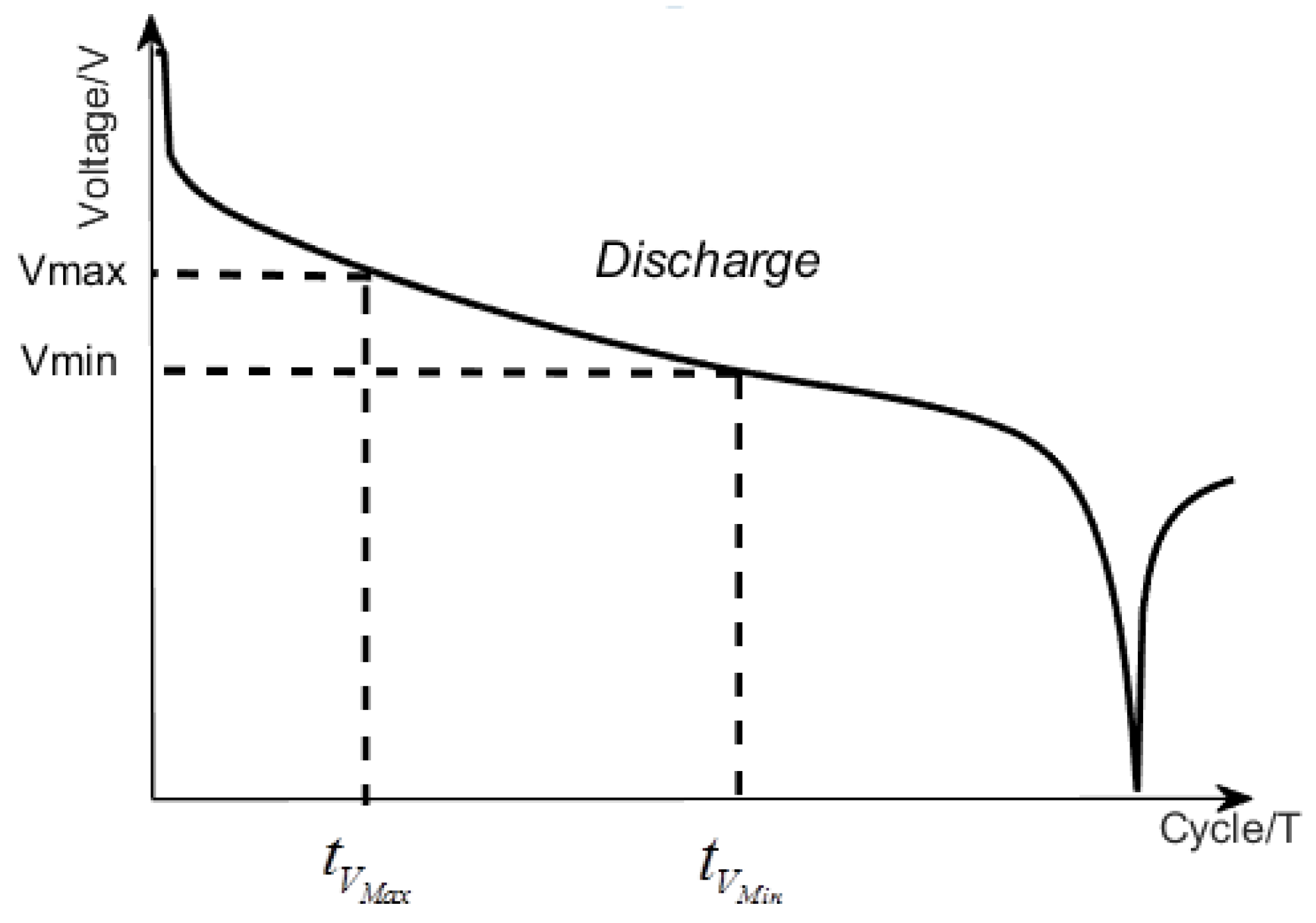

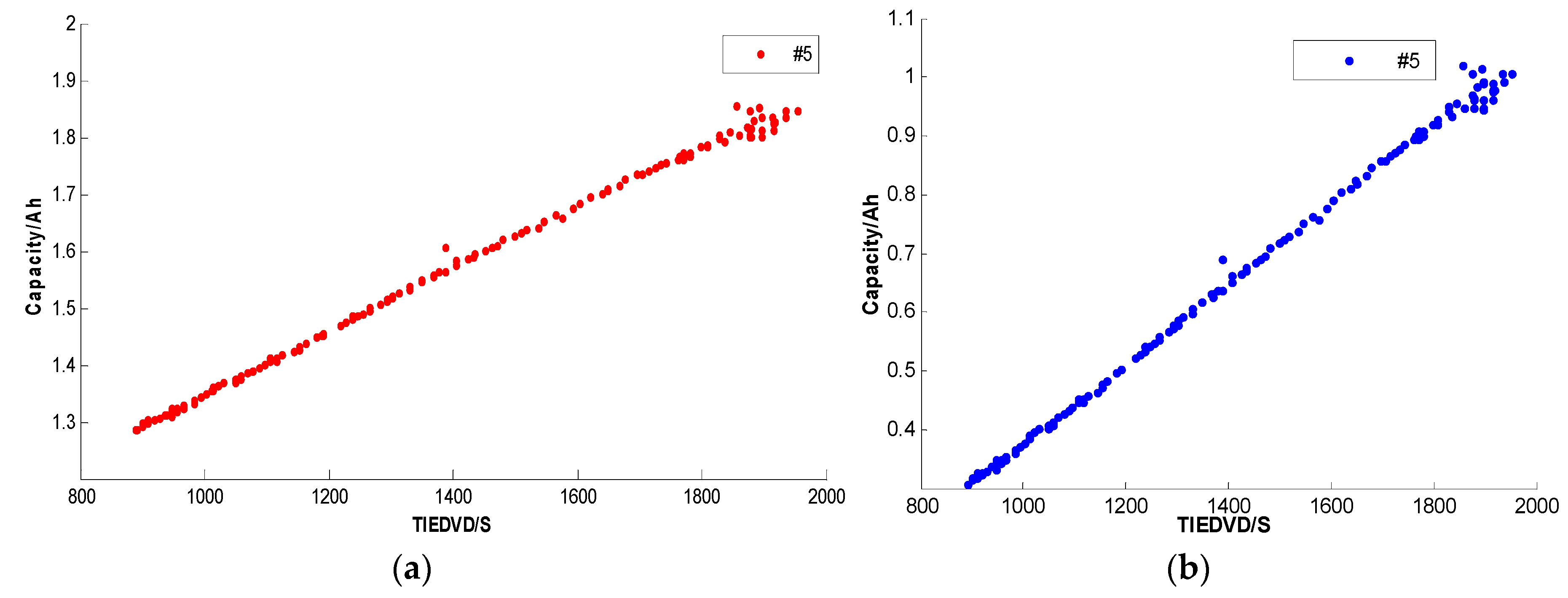
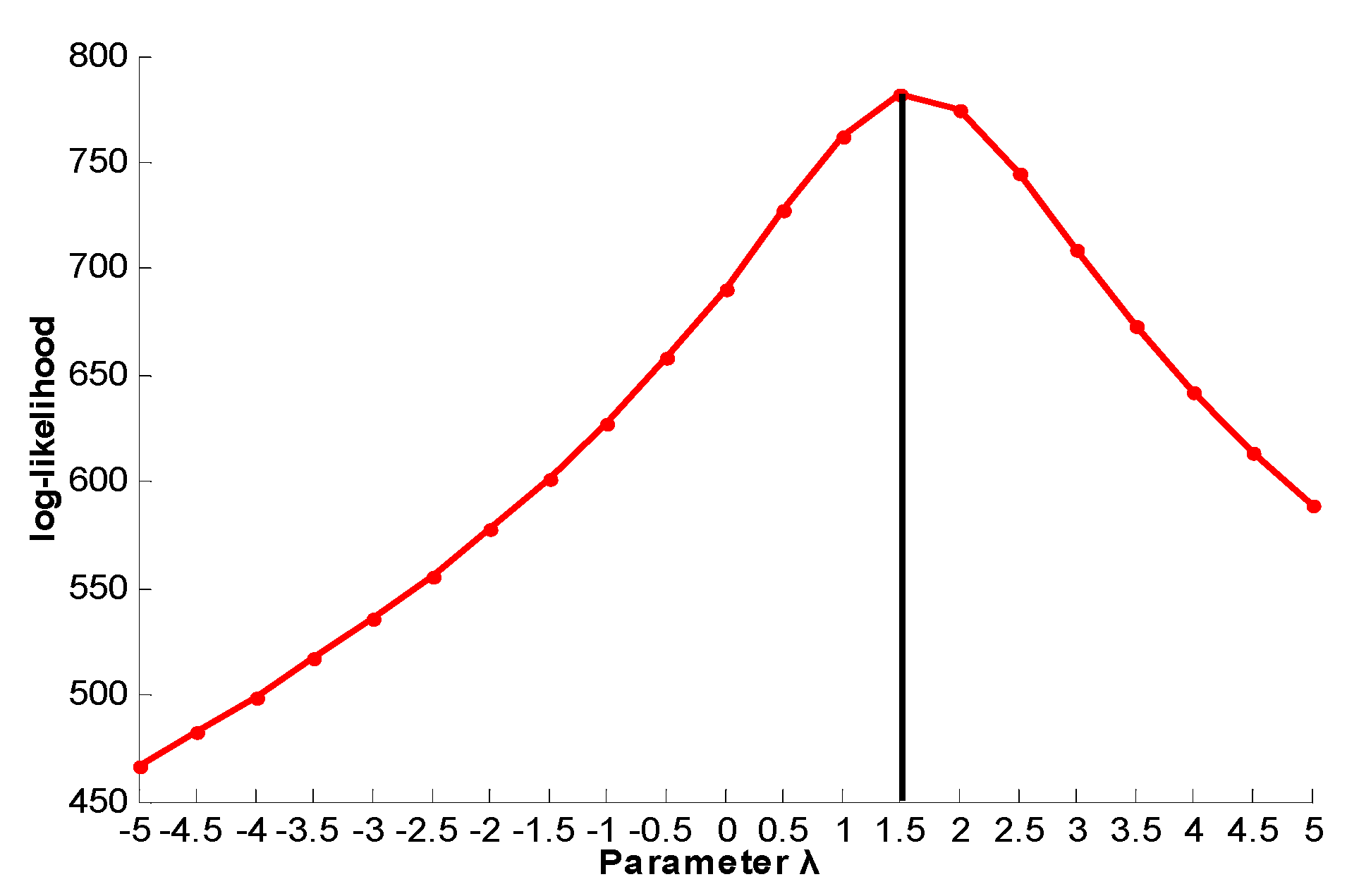
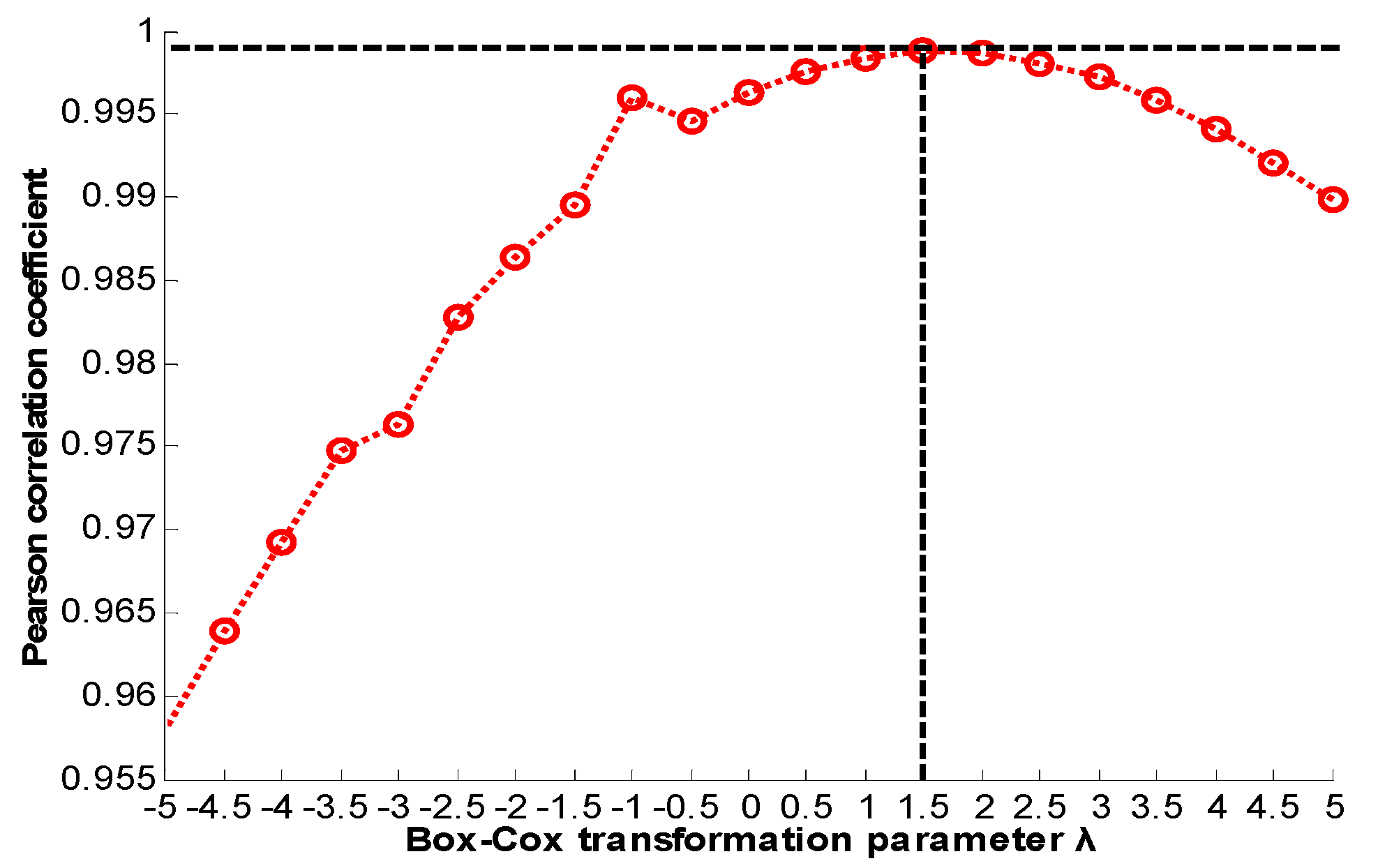
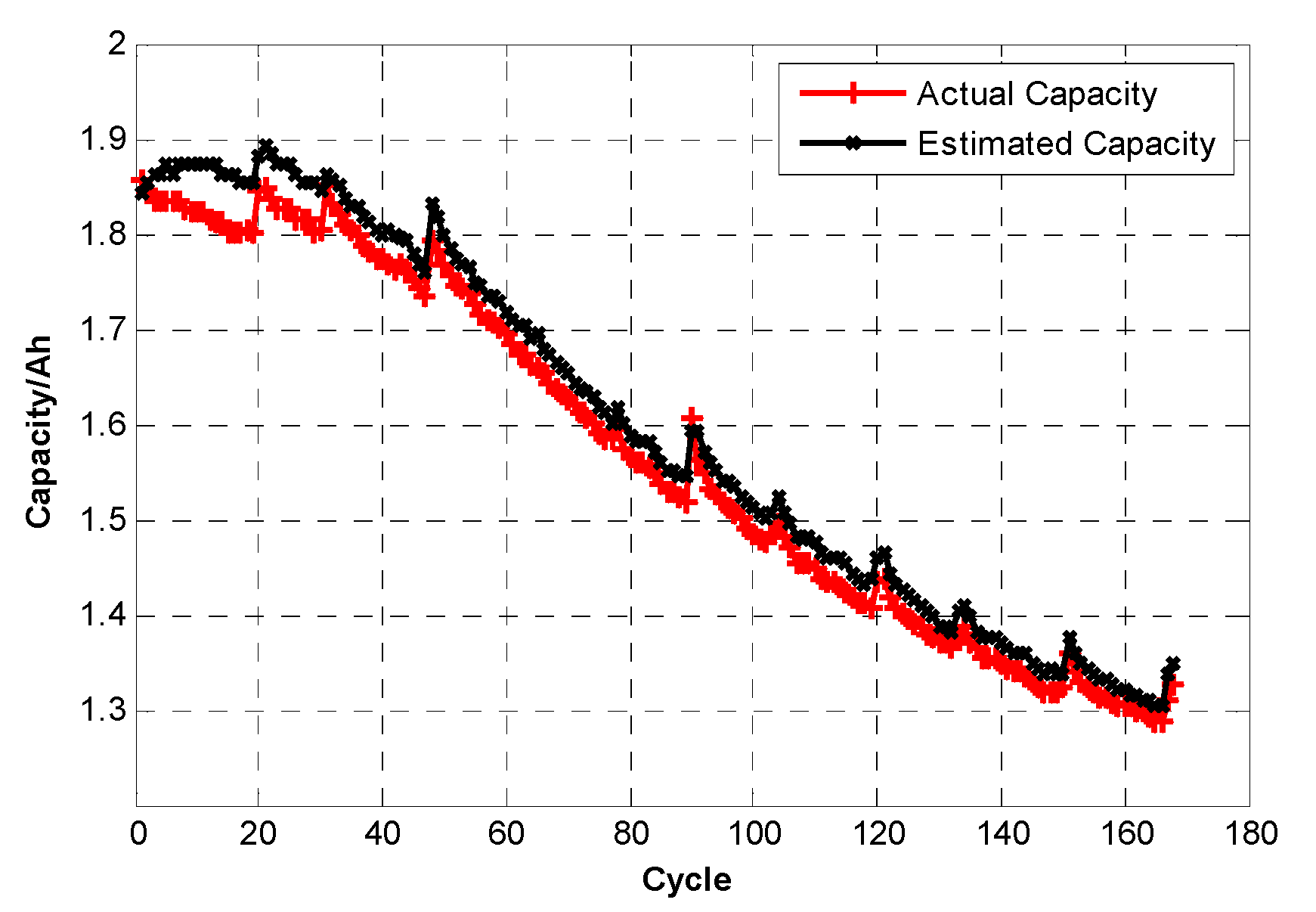
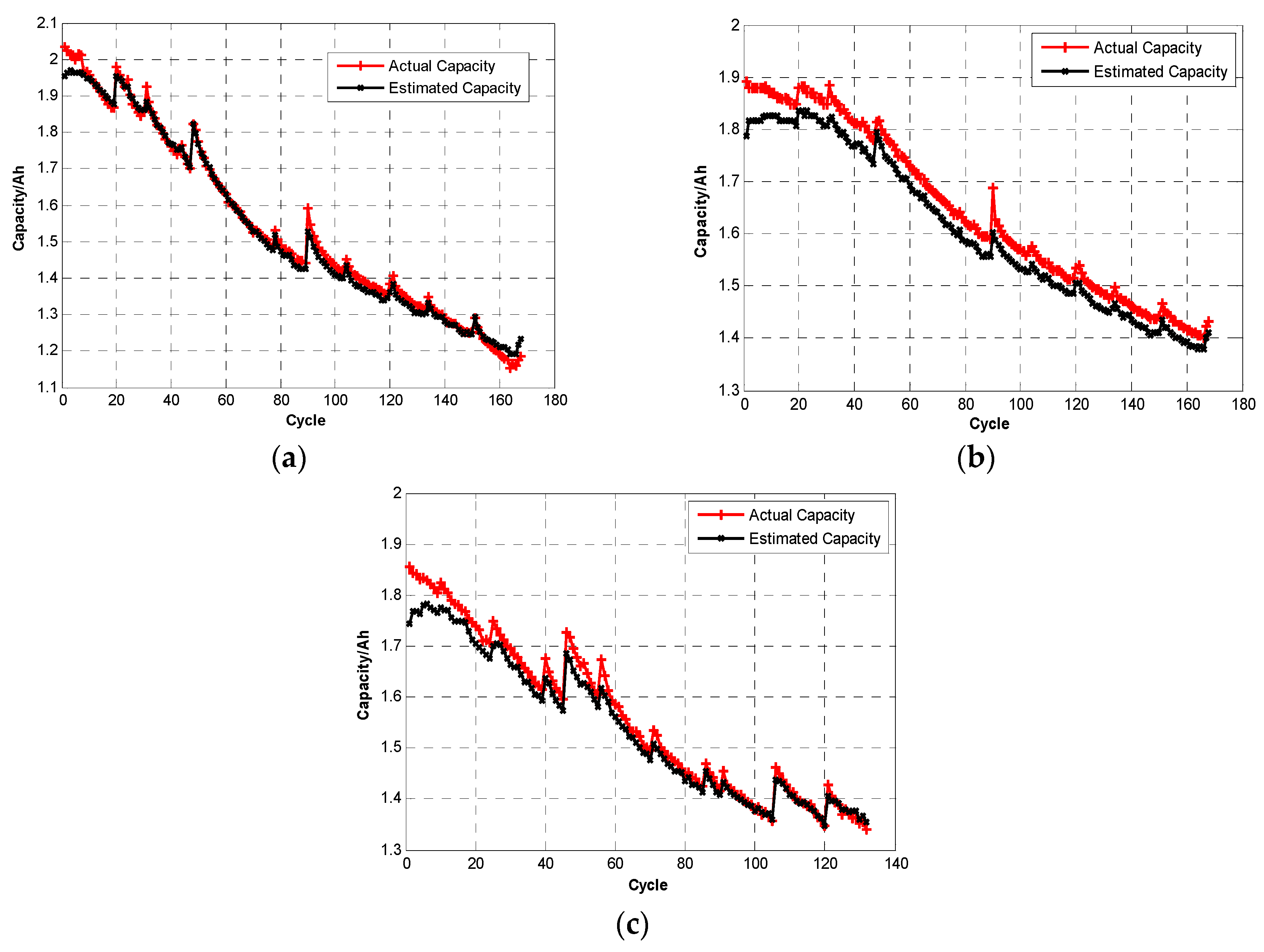
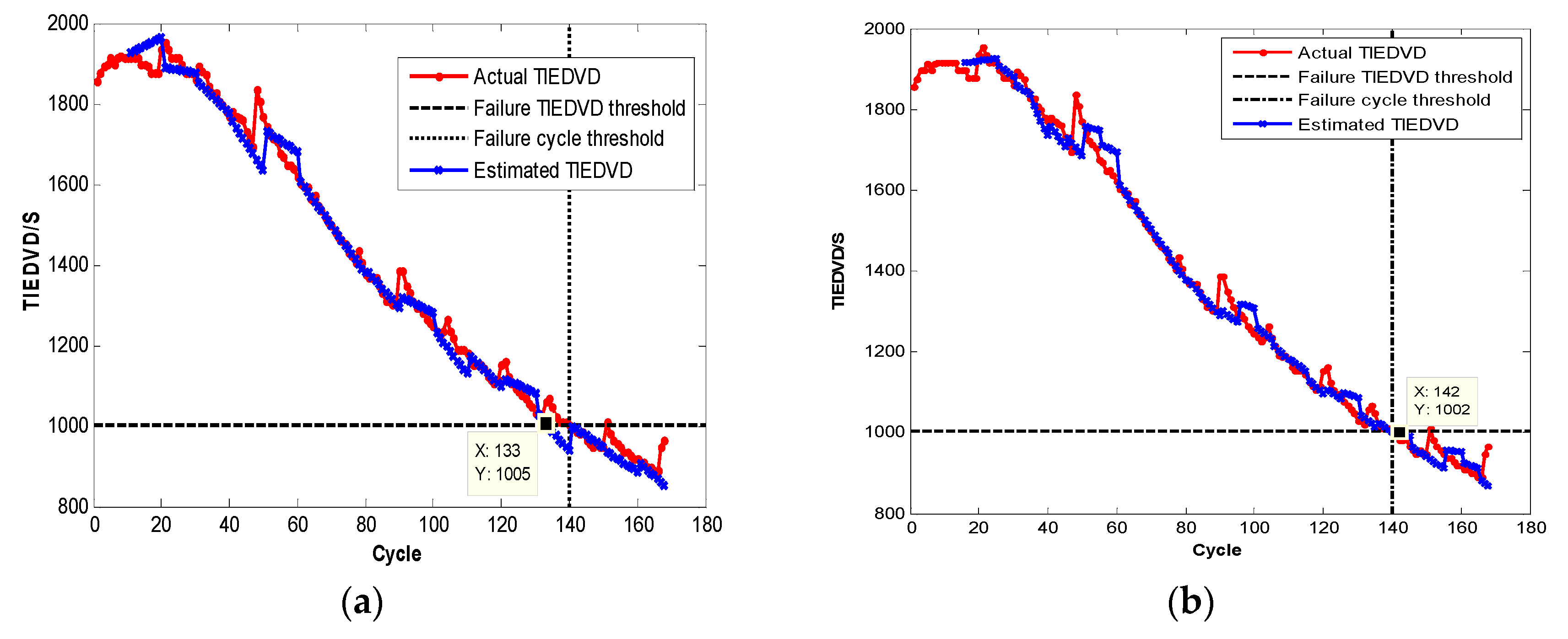

| Time | Pearson Correlation | Spearman Rank Correlation |
|---|---|---|
| Before Box–Cox transformation | 0.9984 | 0.9937 |
| After Box–Cox transformation | 0.9988 | 0.9937 |
| λ | RSEM | R2 |
|---|---|---|
| 1.5 | 0.0297 | 0.9753 |
| Index | λ | RSEM | R2 |
|---|---|---|---|
| #6 | 2.0 | 0.0200 | 0.9937 |
| #7 | 1.0 | 0.0379 | 0.9384 |
| #18 | 0.5 | 0.0273 | 0.9686 |
| Starting Point | Prediction Number | RUL | Predicted RUL | AE | RE |
|---|---|---|---|---|---|
| 10 | 10 | 130 | 123 | 7 | 5.38% |
| 15 | 20 | 125 | 115 | 10 | 8.00% |
| 20 | 5 | 120 | 122 | 2 | 1.67% |
© 2017 by the authors. Licensee MDPI, Basel, Switzerland. This article is an open access article distributed under the terms and conditions of the Creative Commons Attribution (CC BY) license (http://creativecommons.org/licenses/by/4.0/).
Share and Cite
Zhou, D.; Xue, L.; Song, Y.; Chen, J. On-Line Remaining Useful Life Prediction of Lithium-Ion Batteries Based on the Optimized Gray Model GM(1,1). Batteries 2017, 3, 21. https://doi.org/10.3390/batteries3030021
Zhou D, Xue L, Song Y, Chen J. On-Line Remaining Useful Life Prediction of Lithium-Ion Batteries Based on the Optimized Gray Model GM(1,1). Batteries. 2017; 3(3):21. https://doi.org/10.3390/batteries3030021
Chicago/Turabian StyleZhou, Dong, Long Xue, Yijia Song, and Jiayu Chen. 2017. "On-Line Remaining Useful Life Prediction of Lithium-Ion Batteries Based on the Optimized Gray Model GM(1,1)" Batteries 3, no. 3: 21. https://doi.org/10.3390/batteries3030021





